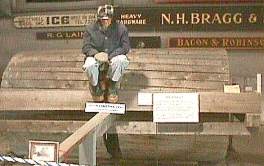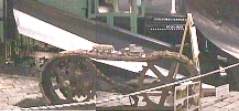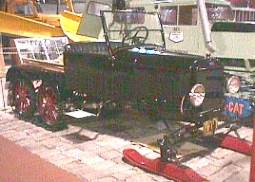Cole Land
Transportation Museum
405 Perry
Road
Bangor, ME
04401
September 20, 2001
This museum is a  fine example of
what private industry can do when it has a desire to pay back to
the community it operates in. The Cole Family started and still
has a very active interest in this museum.
In their statement of purpose they say: the Cole Land
Transportation Museum was established for four specific reasons:
1. To collect, preserve, and display (before they disappear
forever) a cross section of Maine's land transportation equipment
from which this and future generations will gain knowledge of the
past.
2. To honor, with this collection, the thousands of Maine land transportation pioneers whose dedicated work cleared and reshaped
the land, and constructed the highways and rail lines that
allowed the state's development beyond its seacoast. To honor
also those individuals whose determination made it possible -
with primitive tools - to "keep the roads open", year
round through Maine's severe winters - a feat largely
accomplished by the 1930's.
fine example of
what private industry can do when it has a desire to pay back to
the community it operates in. The Cole Family started and still
has a very active interest in this museum.
In their statement of purpose they say: the Cole Land
Transportation Museum was established for four specific reasons:
1. To collect, preserve, and display (before they disappear
forever) a cross section of Maine's land transportation equipment
from which this and future generations will gain knowledge of the
past.
2. To honor, with this collection, the thousands of Maine land transportation pioneers whose dedicated work cleared and reshaped
the land, and constructed the highways and rail lines that
allowed the state's development beyond its seacoast. To honor
also those individuals whose determination made it possible -
with primitive tools - to "keep the roads open", year
round through Maine's severe winters - a feat largely
accomplished by the 1930's.
3. To challenge our young people and help build their aspirations
- - - after seeing what these Maine pioneers accomplished with
hard work, honest endeavor and primitive tools - to believe that
with today's improved knowledge, advanced equipment, and similar
efforts, they also can become creative doers and builders of a
bright future for themselves, their communities and their fellow
man.
4. To record and display U.S. military memorabilia to forever
remind this and future generations of the high price our comrades
have paid to protect our freedom.
The Museum opened in May 1990 in a 40,400 sq. ft. building
constructed especially for the Museum.
Inside they have over 200 vehicles that were used in the land
transportation industry in Maine. In addition they have a
historical collection of over 2,000 photographs that chronicle
life in early Maine communities. They are alleged to have the
largest display of snow removal equipment under one roof in
America. In addition, there are 10 fire trucks which range from a
1910 hand tub to a 1948 Ahrens Fox. In addition to all this they
have special exhibits, throughout the season, of interest to
visitors as well as local residents. On the grounds outside the
museum they also have the official State of Maine World War II
Veterans Memorial as well as a custom-built wooden covered
bridge.
I am not particularly fond of snow, but the snowrollers they had
on exhibit, along with the stories of those who used them were very interesting.
They gave an insight into the early residents of this area, their
stamina and determination. This snow-roller was salvaged from the
outskirts of Twitchell's Airport in Turner, Maine. It was brought
from Leeds, Maine, by Gordon Twitchell and his father in the late
1940s.
It was left to deteriorate in the woods for about 30 years until
it was given to the Cole Family Foundation to rebuild for this
museum. Snow-rollers would have been pulled by two, four, six or
eight horses depending upon the amount and condition of the snow. Old timers recall that when the road had been rolled and frozen, a
car could be driven on it.
This 1933 Model 80 Cletrack tractor with plow was made by the
Portland Co., in Portland, ME. (now Chadwick-
of those who used them were very interesting.
They gave an insight into the early residents of this area, their
stamina and determination. This snow-roller was salvaged from the
outskirts of Twitchell's Airport in Turner, Maine. It was brought
from Leeds, Maine, by Gordon Twitchell and his father in the late
1940s.
It was left to deteriorate in the woods for about 30 years until
it was given to the Cole Family Foundation to rebuild for this
museum. Snow-rollers would have been pulled by two, four, six or
eight horses depending upon the amount and condition of the snow. Old timers recall that when the road had been rolled and frozen, a
car could be driven on it.
This 1933 Model 80 Cletrack tractor with plow was made by the
Portland Co., in Portland, ME. (now Chadwick- BaRoss). It was
sold to John Edgerly of Unity, ME. and delivered by rail. It cost
$8300 including the plows which were made by Maine Steel Products
of Portland. Mr. Edgerly made the wooden cab. It plowed snow from
1933 - 1956 on a 100 mile route from Unity to Liberty, Montville, China,
Thorndike, Benton, Searsmont, Troy and return. Usual
winters required about 20 days of service from this machine. In
1957 the plow was sold to the town of Knox, ME. whose Civil
Defense Dept. reconditioned the track rollers and it was used for
about two years. It was then sold to Dr. John Caswell of
Northport, ME. who lived on a high hill. He used it for a few
more years and later sold it to Harold Drinkwater who used it to
plow around the Blue Goose Dance Hall in Northport. Drinkwater
sold the hall and the Cletrak to Leon Barton who continued to use
it around the dance hall and then sold it to Winston York of
Belfast, ME. in 1975 who intended to use it as a bulldozer but
his plan changed and he sold it to Galen Cole in 1978. It has a
planetary drive which allows one lag to go the opposite direction
of the other so that it can literally turn 180 degrees within its
own radius. Its maximum speed is 4 MPH, its mileage is 4
gallons/mile, and its fuel capacity is 100 gallons of gasoline.
Lombard Log Hauler Track - The pieces of this track assembly were
located by Wayne Duplisea in 1993. Actual site is about five
miles (as the crow flies) North of Allagash Lake and about 75
miles through
BaRoss). It was
sold to John Edgerly of Unity, ME. and delivered by rail. It cost
$8300 including the plows which were made by Maine Steel Products
of Portland. Mr. Edgerly made the wooden cab. It plowed snow from
1933 - 1956 on a 100 mile route from Unity to Liberty, Montville, China,
Thorndike, Benton, Searsmont, Troy and return. Usual
winters required about 20 days of service from this machine. In
1957 the plow was sold to the town of Knox, ME. whose Civil
Defense Dept. reconditioned the track rollers and it was used for
about two years. It was then sold to Dr. John Caswell of
Northport, ME. who lived on a high hill. He used it for a few
more years and later sold it to Harold Drinkwater who used it to
plow around the Blue Goose Dance Hall in Northport. Drinkwater
sold the hall and the Cletrak to Leon Barton who continued to use
it around the dance hall and then sold it to Winston York of
Belfast, ME. in 1975 who intended to use it as a bulldozer but
his plan changed and he sold it to Galen Cole in 1978. It has a
planetary drive which allows one lag to go the opposite direction
of the other so that it can literally turn 180 degrees within its
own radius. Its maximum speed is 4 MPH, its mileage is 4
gallons/mile, and its fuel capacity is 100 gallons of gasoline.
Lombard Log Hauler Track - The pieces of this track assembly were
located by Wayne Duplisea in 1993. Actual site is about five
miles (as the crow flies) North of Allagash Lake and about 75
miles through  the forest from Millinocket, ME. Wayne was
accompanied by Dick Burnham, Galen Cole, and Cliff Vining (all
on staff) on the retrieval mission in 1994. This track is from a
steam-powered Lombard Log Hauler. They were manufactured by
Mainer - Alvin O. Lombard (1856-1937). - in Waterville, ME from
1900-1917. During the 1920s they were gas-powered and
diesel-powered in the 1930s. Typical train length averaged about
eight sleds hauling about fourteen cords or 40,000 board feet. (A
cord is a pile of wood measuring 4'X4'X8'.) The largest
"train" ever reported was 22 sleds. Of great importance
is the fact that the first patent on bull-dozer type tracks was
held by Lombard. All vehicles using this type of device can trace
their history to this Maine invention.
the forest from Millinocket, ME. Wayne was
accompanied by Dick Burnham, Galen Cole, and Cliff Vining (all
on staff) on the retrieval mission in 1994. This track is from a
steam-powered Lombard Log Hauler. They were manufactured by
Mainer - Alvin O. Lombard (1856-1937). - in Waterville, ME from
1900-1917. During the 1920s they were gas-powered and
diesel-powered in the 1930s. Typical train length averaged about
eight sleds hauling about fourteen cords or 40,000 board feet. (A
cord is a pile of wood measuring 4'X4'X8'.) The largest
"train" ever reported was 22 sleds. Of great importance
is the fact that the first patent on bull-dozer type tracks was
held by Lombard. All vehicles using this type of device can trace
their history to this Maine invention.
 MODEL
TT SNOWMOBILE: This is a 1926 Model T Ford car fitted with a
Snowmobile Attachments manufactured by The Snowmobile Co., Inc.
of West Ossipee, NH. Some of the pieces were made for them by the
Snow & Neally Co. of Bangor. The attachment was invented by
Virgil D. White in 1913 but not marketed until 1922. They were
sold by Ford dealers throughout the snow country of the US and in
some foreign countries. Some were even used in the sand deserts
of Algeria, Egypt, and South Africa. To accommodate the extra set
of rear wheels, the attachment kit lengthened the chassis 20
inches by including a worm driver rear axle assembly and springs.
The differential is used in Model TT trucks hence the "Model
TT" reference. The "Snowmobile" is a Model A-44
Special, so designated because the runners are 44 inches apart
which corresponds to those on many sleighs and sleds used at the
time. It was especially designed for the 1926-27 Ford Runabouts.
The company boasted that the Snowmobile would go over snow that
horse and sleight couldn't. These vehicles were used by a great
variety of people but probably most often by mail carriers and
physicians. This unit was found by Bill White of Presque Isle,
ME. Mr. White believes it was used as a utility vehicle on the
Thompkins farm, State Road, Presque Isle, during the late 1920s
to the mid-1920s when they began to plow the roads north of Old
Town, ME. a practice started by Allie Cole. Restored to nearly
new running condition by Mr. Wakem, it was acquired by the museum
in 1999.
MODEL
TT SNOWMOBILE: This is a 1926 Model T Ford car fitted with a
Snowmobile Attachments manufactured by The Snowmobile Co., Inc.
of West Ossipee, NH. Some of the pieces were made for them by the
Snow & Neally Co. of Bangor. The attachment was invented by
Virgil D. White in 1913 but not marketed until 1922. They were
sold by Ford dealers throughout the snow country of the US and in
some foreign countries. Some were even used in the sand deserts
of Algeria, Egypt, and South Africa. To accommodate the extra set
of rear wheels, the attachment kit lengthened the chassis 20
inches by including a worm driver rear axle assembly and springs.
The differential is used in Model TT trucks hence the "Model
TT" reference. The "Snowmobile" is a Model A-44
Special, so designated because the runners are 44 inches apart
which corresponds to those on many sleighs and sleds used at the
time. It was especially designed for the 1926-27 Ford Runabouts.
The company boasted that the Snowmobile would go over snow that
horse and sleight couldn't. These vehicles were used by a great
variety of people but probably most often by mail carriers and
physicians. This unit was found by Bill White of Presque Isle,
ME. Mr. White believes it was used as a utility vehicle on the
Thompkins farm, State Road, Presque Isle, during the late 1920s
to the mid-1920s when they began to plow the roads north of Old
Town, ME. a practice started by Allie Cole. Restored to nearly
new running condition by Mr. Wakem, it was acquired by the museum
in 1999.
